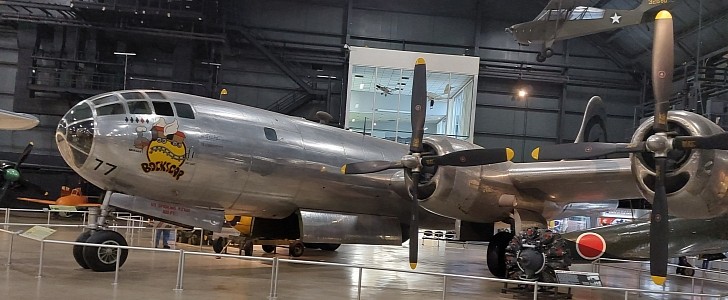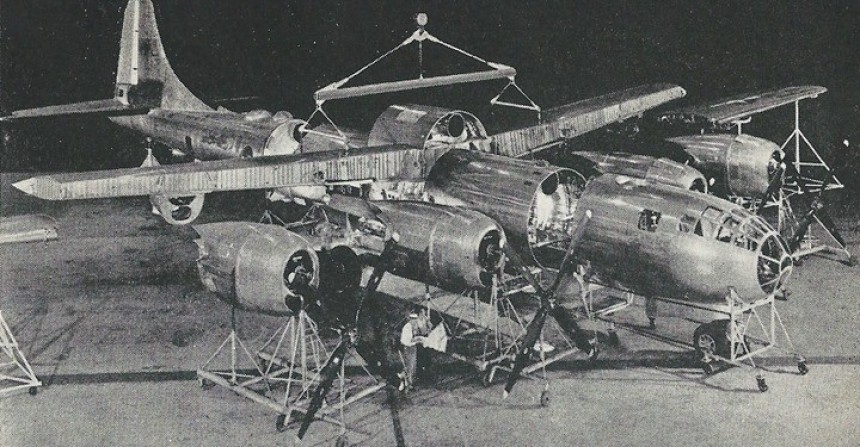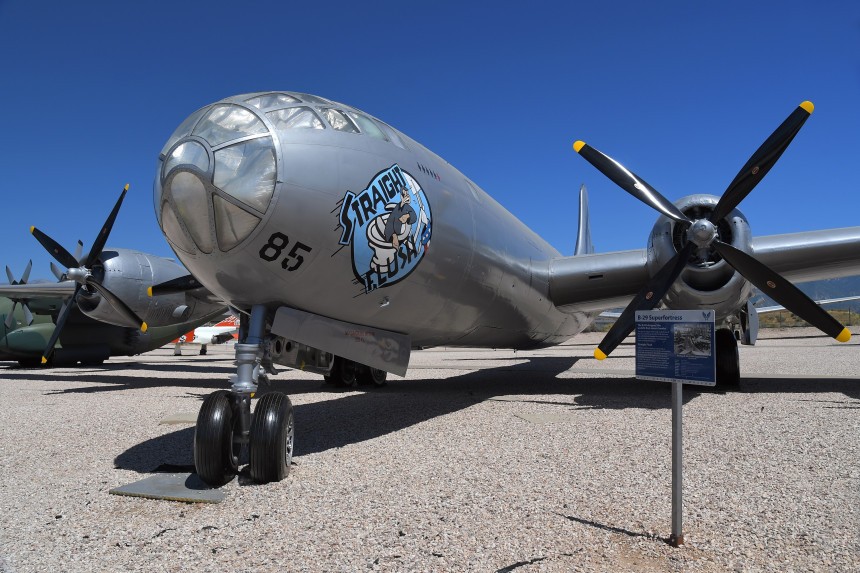A couple of months ago, we traveled to the Stephen Udvar-Hazy Center in Chantilly, Virginia. The official annex of the Air and Space Museum in Washington D.C. Debatably, granted, the star attraction is the Enola Gay, an airplane that needs no introduction whatsoever.
Along with Bockscar, another B-29, the two are often credited with bringing an end to almost eight years of brutal fighting between Imperial Japan and the Allied powers. But did you know these two icons come from a lineage of over 80 specially modified B-29s purpose-built for the Manhattan Project? It's a piece of wisdom that tends to get lost in translation quite a bit.
You see, by June 1943, the Allied nations were inching ever closer to their goal of a functioning fission reactor atom bomb. Project scientist Dr. Norman F. Ramsey of Los Alamos Laboratories concluded that the Boeing B-29 was the only American airplane remotely capable of carrying such a large and powerful weapon. But there was a problem. The B-29 was becoming a costly albatross around the U.S. Air Force, growing larger as each month passed.
No one knew for certain whether the Superfortress would be ready in time for its operational objective. The problem was so bad at one point that the Americans breifly discussed giving the job to the British Avro Lancaster bomber instead, although that idea never materialized into anything substantive. Still, such an idea was a humiliating prospect for the emerging American superpower. Happily, Boeing's engineers pulled through, and the first B-29 was delivered in the summer of 1943.
Around this time, the director of the Manhattan Project, Major General Leslie R. Groves Jr, and General of the Army Air Corps Henry "Hap" Arnold agreed that a limited production run of modified Superfortress bombers would be needed to ensure atomic weapons could be delivered by an American aircraft specifically. The special bombers would utilize a single 33-foot (ten-meter) single bomb bay door in place of the usual four 12-foot (3.7-meter) doors.
Mounting points were installed to allow for different types of bomb types, nuclear isotopes, shapes, and firing mechanisms currently under study in the Nevada Desert. At this time, the designation "Silver Plate" had already been informally adopted and then changed to a singular "Silverplate," in order to throw off intelligence operations conducted by the Germans and Japanese, the clever B.S. line was spun in the press regarding its origins.
Legend has it a phony story was written up implying the Silverplate moniker was the designation for a modified Pullman train car. One devised for use in U.S. President Franklin Roosevelt and U.K Prime Minister Winston Churchill's personal rail transportation system. Evidently, the elaborate ruse worked to perfection, as there's no evidence of a warning being issued by Imperial Japan before the first bomb was dropped in August 1945.
The Silverplate B-29s continued to serve in the nuclear payload carrier role for another eight years until November 1951. At which point, many were phased out in favor of the heavily modified B-50 Superfortress or were reassigned to other duties. Before this date, in 1947, it was discovered that the Silverplate codename had been compromised. The program was then re-named project Saddletree.
Over time, Saddletree became a designation not just for B-29s but also for B-50s, Convair B-36 Peacemakers, and Boeing C-97 Stratofreighters. It's believed that as many as 80 Silverplate B-29 airframes left Boeing's Witchita, Kansas production facility. The Silverplate standard was heavily mimicked with the Tupolev Tu-4 Bull, the Soviet reverse-engineered Superfortress. A bomber also generally agreed to be nuclear ordinance compatible.
To reiterate, the B-29 was a bit like what the F-35 Joint Strike Fighter program is to the U.S. Military today, but back in the 1940s. A complete and airworthy single unmodified B-29 cost $782,000 in 1945 or around $12,000,000 in today's money. The cost of the Silverplate modifications brought the cost up to roughly $814,000 in 1945 or $12.85 million per airframe in 2022. With all the logistics included, the cost of the Silverplate program was around $60 million in 1945, or just shy of $1 billion.
It's thought the total cost of the B-29 program roughly translates to $3 billion by 1945 money or a whopping $43 billion in 2022. Here's a stat that'll blow your mind. The cost of the entire B-29 Superfortress program from start to finish costs a little over 10% of what it costs the F-35 JSF over its lifetime. What does this tell us? Well, perhaps we should be less wishy-washy with who we allow access to the Pentagon's checkbooks. We used to be able to get things done a heck of a lot cheaper 75 years ago.
Check back for more from Limited Edition Month here on autoevolution.
You see, by June 1943, the Allied nations were inching ever closer to their goal of a functioning fission reactor atom bomb. Project scientist Dr. Norman F. Ramsey of Los Alamos Laboratories concluded that the Boeing B-29 was the only American airplane remotely capable of carrying such a large and powerful weapon. But there was a problem. The B-29 was becoming a costly albatross around the U.S. Air Force, growing larger as each month passed.
No one knew for certain whether the Superfortress would be ready in time for its operational objective. The problem was so bad at one point that the Americans breifly discussed giving the job to the British Avro Lancaster bomber instead, although that idea never materialized into anything substantive. Still, such an idea was a humiliating prospect for the emerging American superpower. Happily, Boeing's engineers pulled through, and the first B-29 was delivered in the summer of 1943.
Around this time, the director of the Manhattan Project, Major General Leslie R. Groves Jr, and General of the Army Air Corps Henry "Hap" Arnold agreed that a limited production run of modified Superfortress bombers would be needed to ensure atomic weapons could be delivered by an American aircraft specifically. The special bombers would utilize a single 33-foot (ten-meter) single bomb bay door in place of the usual four 12-foot (3.7-meter) doors.
Legend has it a phony story was written up implying the Silverplate moniker was the designation for a modified Pullman train car. One devised for use in U.S. President Franklin Roosevelt and U.K Prime Minister Winston Churchill's personal rail transportation system. Evidently, the elaborate ruse worked to perfection, as there's no evidence of a warning being issued by Imperial Japan before the first bomb was dropped in August 1945.
The Silverplate B-29s continued to serve in the nuclear payload carrier role for another eight years until November 1951. At which point, many were phased out in favor of the heavily modified B-50 Superfortress or were reassigned to other duties. Before this date, in 1947, it was discovered that the Silverplate codename had been compromised. The program was then re-named project Saddletree.
Over time, Saddletree became a designation not just for B-29s but also for B-50s, Convair B-36 Peacemakers, and Boeing C-97 Stratofreighters. It's believed that as many as 80 Silverplate B-29 airframes left Boeing's Witchita, Kansas production facility. The Silverplate standard was heavily mimicked with the Tupolev Tu-4 Bull, the Soviet reverse-engineered Superfortress. A bomber also generally agreed to be nuclear ordinance compatible.
It's thought the total cost of the B-29 program roughly translates to $3 billion by 1945 money or a whopping $43 billion in 2022. Here's a stat that'll blow your mind. The cost of the entire B-29 Superfortress program from start to finish costs a little over 10% of what it costs the F-35 JSF over its lifetime. What does this tell us? Well, perhaps we should be less wishy-washy with who we allow access to the Pentagon's checkbooks. We used to be able to get things done a heck of a lot cheaper 75 years ago.
Check back for more from Limited Edition Month here on autoevolution.







